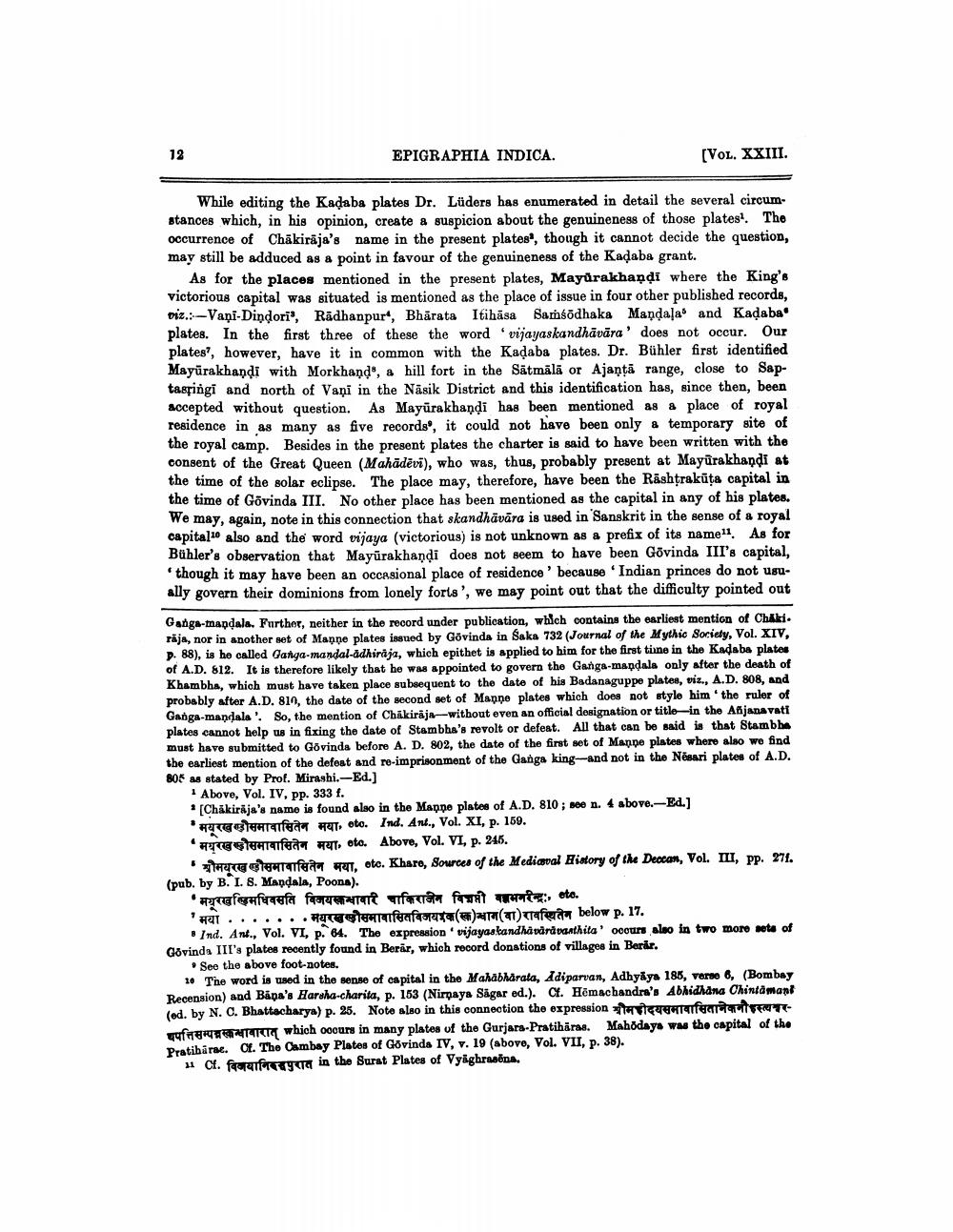________________
12
EPIGRAPHIA INDICA.
While editing the Kadaba plates Dr. Lüders has enumerated in detail the several circumstances which, in his opinion, create a suspicion about the genuineness of those plates1. The occurrence of Chakiraja's name in the present plates, though it cannot decide the question, may still be adduced as a point in favour of the genuineness of the Kaḍaba grant.
[VOL. XXIII.
As for the places mentioned in the present plates, Mayurakhandi where the King's victorious capital was situated is mentioned as the place of issue in four other published records, viz.:-Vani-Dindori, Radhanpur, Bharata Itihasa Samsōdhaka Mandala and Kadaba plates. In the first three of these the word 'vijayaskandhāvāra' does not occur. Our plates, however, have it in common with the Kadaba plates. Dr. Bühler first identified Mayurakhandi with Morkhand, a hill fort in the Sätmälä or Ajanṭā range, close to Saptasringi and north of Vani in the Nasik District and this identification has, since then, been accepted without question. As Mayurakhaṇḍi has been mentioned as a place of royal residence in as many as five records, it could not have been only a temporary site of the royal camp. Besides in the present plates the charter is said to have been written with the consent of the Great Queen (Mahadevi), who was, thus, probably present at Mayurakhandi at the time of the solar eclipse. The place may, therefore, have been the Rashtrakuta capital in the time of Govinda III. No other place has been mentioned as the capital in any of his plates. We may, again, note in this connection that skandhavara is used in Sanskrit in the sense of a royal capitalo also and the word vijaya (victorious) is not unknown as a prefix of its name11. As for Bühler's observation that Mayurakhandi does not seem to have been Govinda III's capital, though it may have been an occasional place of residence' because 'Indian princes do not usually govern their dominions from lonely forts', we may point out that the difficulty pointed out
Ganga-mandala. Further, neither in the record under publication, which contains the earliest mention of Chaki. raja, nor in another set of Manne plates issued by Govinda in Saka 732 (Journal of the Mythic Society, Vol. XIV, p. 88), is he called Ganga-mandal-adhiraja, which epithet is applied to him for the first time in the Kadaba plates of A.D. 812. It is therefore likely that he was appointed to govern the Ganga-mandala only after the death of Khambha, which must have taken place subsequent to the date of his Badanaguppe plates, viz., A.D. 808, and probably after A.D. 810, the date of the second set of Manne plates which does not style him 'the ruler of Ganga-mandala. So, the mention of Chakiraja-without even an official designation or title-in the Añjanavati plates cannot help us in fixing the date of Stambha's revolt or defeat. All that can be said is that Stambha must have submitted to Govinda before A. D. 802, the date of the first set of Manne plates where also we find the earliest mention of the defeat and re-imprisonment of the Ganga king-and not in the Nesari plates of A.D. 805 as stated by Prof. Mirashi.-Ed.]
Above, Vol. IV, pp. 333 f.
[Chakiraja's name is found also in the Mappe plates of A.D. 810; see n. 4 above.-Ed.] geelementer, etc. Ind. Ant., Vol. XI, p. 159.
Safe, etc. Above, Vol. VI, p. 245.
6 since stemmanfera a, etc. Khare, Sources of the Mediaeval History of the Deccan, Vol. III, pp. 271. (pub. by B. I. S. Mandala, Poona).
* मयूरखण्डिमधिवसति विजयस्कन्धावारे चाकिराजेन विशप्तो बज्ञभनरेन्द्रः ete.
•
मया
• मयूरस्वछीसमावासितविजयश्क (स्क) स्थान (वा) रावस्थितेन below p. 17.
Ind. Ant., Vol. VI, p. 64. The expression vijayaskandhäväravasthita' occurs also in two more sets of Govinda III's plates recently found in Berar, which record donations of villages in Berar.
See the above foot-notes.
10 The word is used in the sense of capital in the Mahabharata, Adiparvan, Adhyaya 185, verse 6, (Bombay Recension) and Bapa's Harsha-charita, p. 153 (Nirnaya Sagar ed.). Cf. Hemachandra's Abhidhana Chintamant (ed. by N. C. Bhattacharya) p. 25. Note also in this connection the expression ariceremtanfean aritzepz faezeki which occurs in many plates of the Gurjara-Pratihāras. Mahodaya was the capital of the Pratibarac. Cf. The Cambay Plates of Govinda IV, v. 19 (above, Vol. VII, p. 38).
11Cf. faceface in the Surat Plates of Vyaghrasena.




